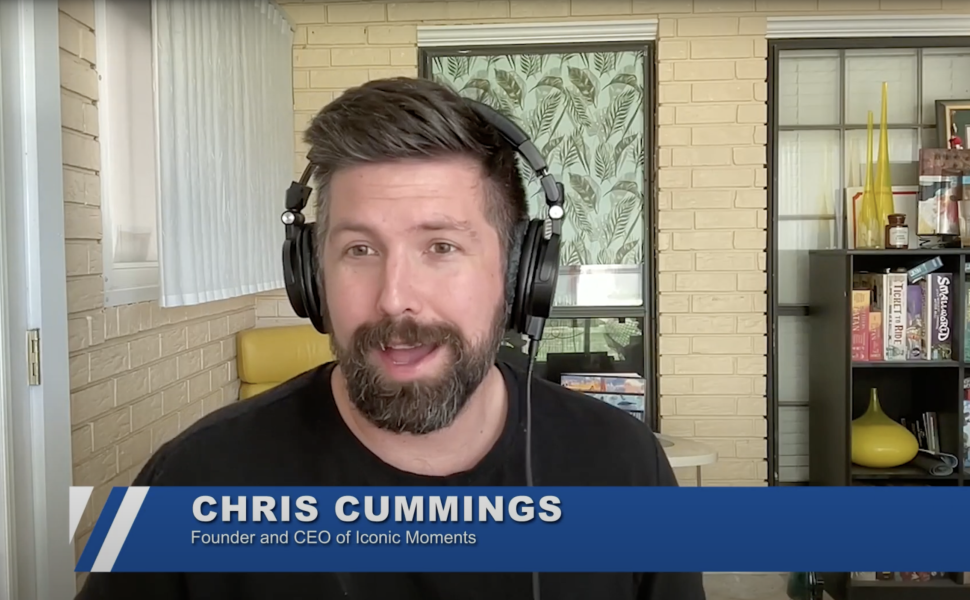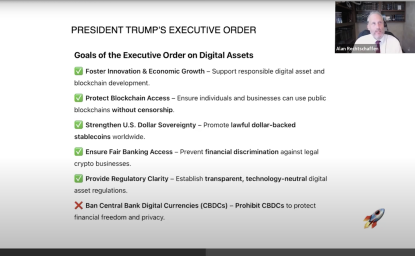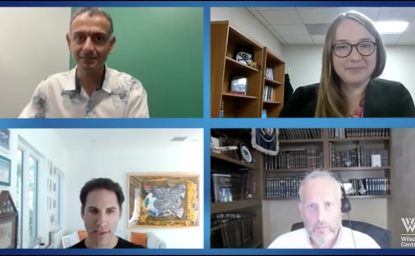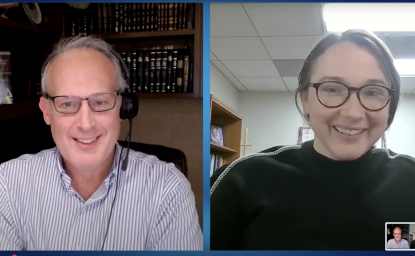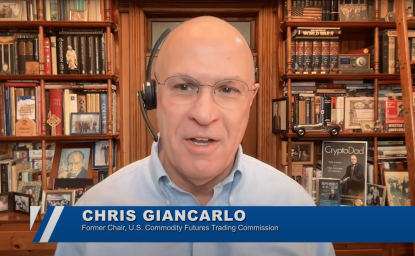Narrator: Welcome to Blockchain Explained, a podcast about opportunities, challenges, and trends in blockchain technology. Whether you're a beginner or an expert, a developer or just crypto-curious, this podcast is for you. It features industry leaders and government officials discussing the world of distributed ledgers, cryptocurrencies, and the metaverse. And now, here are your hosts, Alan Rechtschaffen and Kellee Wicker.
Kellee Wicker: Hello, and welcome back to another episode of Blockchain Explained. I am Kellee Wicker, Director of the Science and Technology Innovation Program at the Wilson Center, and I'm joined by my co-host, Alan Rechtschaffen, Wilson Center Trustee and Chair of Digital Assets Forum. We're really delighted to be joined today by Chris Cummings, the CEO and founder of Iconic Moments, which is a company that expands access to cultural experiences to digital innovation. I'm really excited to hear more from him about how digital assets can help museums, cultural institutions, nonprofits expand their reach. So Alan, I'll kick it to you to get us started.
Alan Rechtschaffen: Great. Thank you, Kellee. It's always great being with you and Chris. Welcome to welcome to our podcast. I'd love to understand what you do. I looked at your website and it sounds like you're doing all sorts of great things with the White House Historical Society and a bunch of cultural institutions, Norman Rockwell, and I'd like to understand how you are taking this technology, which we're very focused on in the context of the Digital Assets Forum, and turning into something that's helping these institutions, these cultural institutions.
Chris Cummings: Yeah, absolutely. Well, first and foremost, thank you guys for having us on the podcast. It's good to see you again, Kellee. Great to get a chance to meet you, Alan. And I really appreciate, you know, the podcast helping to dispel, right, and make easy to understand what is the blockchain, because I think that for most people, it still is this very odd, mythical, quirky thing they've read in the news that's often not accurate as to what it actually is. So, you know, like I think I have the greatest job in the world. I founded Iconic and its parent company close to a decade ago. And our work is getting to work with cultural institutions and museums all around the world to help them to embrace digital technology, to help them to reach new audiences, to help them to make their collections more accessible and more interesting dynamic and to really focus on how we can reach a new generation, a new generation of visitors that may not walk through the door of a museum, but could if you reach them in a new manner. So, Iconic is a global digital platform for culture, culture and entertainment. So, a part of what we do is within Iconic Moments and Iconic Moments is a marketplace that's focused on creating digital and physical collectibles for cultural institutions and cultural and museums. So, part of our work is in helping to utilize blockchain technology might be through doing NFTs a certificate of authenticity tied to like a limited edition print or it might be doing a new work of art with a digital artist that's inspired by something within the museum's collection. And then, the other component of our work is a new platform we've been working on for quite a while, which is a 3D storytelling platform to actually build digital twins of museums, utilizing blockchain technology in the back end to change the way that we experience culture.
Kellee Wicker: It sounds like, the digital twins, especially one of the questions I wanted to ask was how your work has changed since COVID created both a new need for digital experiences, but also some opportunities for companies like yours, was the digital twin experience kind of born out of that.
Chris Cummings: You know, it's interesting is that a big part of our expansion to founding iconic, was really looking at COVID and starting to question the underlying model of support for culture and cultural institutions. So, if you look at how most cultural institutions are funded and supported, and then you look at COVID, you can understand why culture got into so much trouble, right? So, in COVID, 94 percent of institutions closed at the exact same time. And then, in the U. S., over 55 percent of our institutions became at risk of closing permanently. You know, worldwide, that number was like 33 percent. And the reason those numbers were so high is that the primary ways that museums and other cultural institutions make revenue is through tickets, it's through events and it's through galas, right? Where they serve, for some reason, the same chicken, uh, at every same gala and they ask the same high net worth individuals and trust every year to write the same checks. The truth is that that model of support was failing before COVID and then COVID just accelerated all of it and it poured gasoline on this fire. And so, the culture industry is in crisis, right? It's in crisis as to what to do. And a lot of institutions hoped that when COVID was over, that the world would come back to normal, that tourism would come back to normal and they wouldn't have to do new stuff. But the dirty secret no one's talking about is that tourism has not come back. You know, for a lot of cultural institutions around the world, their tourism numbers are only at 30 to 40 percent of where they were before COVID. And if, you're a European institution, for example, funded by a tourism tax, you're in trouble, right? You're at risk of closing today. So what I would say is that COVID, 1), showed, I would say, the underlying weakness in the model of financial support for our cultural institutions. And 2), it really helped to, I think, accelerate that understanding that we need to create new models. We need to find ways to engage people digitally. We need to find ways to drive revenue digitally. We need to expand our focus beyond just what we do within the doors of our business. And I think that they're quickly beginning to figure that out. And, unfortunately, right, the crisis moment is they have to figure out where they may be gone for a lot of these institutions. I mean, I got a call yesterday from a five-museum network in the UK where if they can't figure out an economic model, they might have to close four of those institutions and like that should never happen, right? We should not be at risk of losing this. And it's because museums today primarily operate the same way they operated a hundred years ago. So taking that a step further, what I'd also say, though, is that, the other area that I think is interesting is that there are a bunch of new businesses that are not museums, that are stealing the visitors away that would typically go to museums by being a little more immersive, by being a little more experiential. If you look at like Meow Wolf or Secret Cinema or any of like Borderless's or Team Labs's work with Borderless or even, you know, often the quality's not there in the U. S. compared to the rest of the world, kind of the projection experiences of Monet or Van Gogh. You know. If a family of kids is trying to say, do I go to the traditional art museum today, or do I go to this new experiential thing? They're often choosing the new experiential thing. And so, museums really do need to evolve and figure out what can we do to bring people back in the door or try new things. So, I would say that a lot of our work now is kind of activating on this momentum to try to push a new model and to say, we're not replacing your physical museum, but we are helping you to, you know, reach someone, for example, in China that will never physically walk through your door, but knows about your museum and wants to engage with you in a variety of different ways. And so digital twins are an extension of that, right? It's a way to allow someone to interact with your museum, to have a digital ticketing model behind it, or a digital membership model. And what we're replacing is pretty crappy, right? Like, I've never heard anyone go, man, I had a great virtual tour. Every institution has like a Matterport or photo stitched together. And they just kind of make you want to go to the real place. Cause that experience is, is pretty bad UI UX. It feels like you're in 1995, but if you can make something that feels like a AAA video game and allow someone to really explore and interact and make that very intuitive, that's new. That's a new experience. And I think that that's, that's where the future is going.
Alan Rechtschaffen: Wait, Chris, can I ask you something? You know, you've, you've spoken about this on a very high level. I would like to understand what is. Let's take the, the White House, um, it's called the White House Historical Society, right?
Chris Cummings: White House Historical Association.
Alan Rechtschaffen: Can you walk us through what an experience looks like and where the blockchain technology is part of this and how it's the backbone of what you're doing? And just, let me understand the user experience. And, and complement that, juxtapose that with an explanation of where the technology is coming in to facilitate that user experience that's different than a cloud-based experience where, you know, circa 1995 virtual tour, what is new here?
Chris Cummings: Yeah, so for both the White House Historical Association, and I'll also walk you through like the Jackson Pollock Studio Collection. Those are both on the collectible side of what we do, but, all built on kind of blockchain technology. So, for example, with the White House Historical Association, that's essentially, a really amazing organization set up by Jackie Kennedy in the 1960s to help really be responsible for protecting a lot of the artwork and the items up in the White House itself. And also responsible for the education side of it. They wanted to find a way to reach new audiences, to extend their mission, and to find a way to enter into, I would say the digital art space, and the NFT space, in an elegant way and do it the right way. So for that particular project, we worked with an original piece of artwork in the White House collection, which is Alma Thomas's Resurrection. This is the very first piece of artwork by an African American woman, that was acquired and resides within the White House by the Obama administration in 2012. Wow. And so, we wanted to find a way to tell both Alma's story and that artwork, and also how it's impacted future artists. So for that campaign, we found an amazing digital artist named Linda Dunia, who is one of Time's top 100 AI voices in the entire world, considered one of the top digital artists in the entire world. And so, she actually reinterpreted Thomas's artwork and then created a new piece of artwork called Sparrows Do Not Fear The Sun, which was an amazing piece of digital art. That was also built upon using AI technology and in a lot of her techniques, which is blending physical and digital mediums together. And then we released it, as a NFT where you could buy this new artwork, but it also told you the story of how it was linked to that original artwork. And so, this functioned as a storytelling tool, this function is an educational tool, and it also allowed the White House Historical Association to reach new audiences around the world, who had a chance to engage with the organization and to collect from the organization. And then there was this fundraising element and charity element. Another great example, though, is the Jackson Pollock studio collection we launched with the Jackson Pollock House and Study Center. So this is the Jackson Pollock House and Study Center is an amazing nonprofit that falls underneath Stony Brook University, and the House and Study Center is where Jackson Pollock and Lee Krasner lived. It is where Pollock painted all of his great masterworks. And so after Pollock's death, The studio floor was covered up for 30 years and kind of forgotten about, but then it was discovered in the late 80s and early 90s, and now today it's considered one of the most important national landmarks and national art artifacts in the entire world. So what we did for that project is we digitized the studio floor with one of the world's fanciest cameras, and we then were able to create four artifacts, from the studio floor itself that were both -- the NFT on the blockchain would function as a certificate of authenticity because physical certificates of authenticity, which is what we typically use, don't make a lot of sense. Like, they're easy to lose, to be damaged, they're prone to fraud, but, you know, using NFTs as a certificate of authenticity on a distributed ledger system makes a ton of sense. And then we released four limited edition prints from the Jackson Pollock studio floor. So not artworks, but artifacts in that case. And, that campaign was a huge success. The entire campaign sold out in less than three hours, generating over $500,000 in revenue with purchases from over 25 countries. The campaign generated over five and a half million media impressions. Artnet called it one of the three largest stories in the entire art world in July alongside Frieze's expansion and Barbenheimer. And for a two person non-profit in the Northeast, we, you know, allowed them to run one of the most successful campaigns in the entire world in digital art while making a significant amount of revenue and then extending the reach of Pollock to educate people about Pollock, his technique, and the studio floor which function as a tool to preserve the studio floor.
Alan Rechtschaffen: Chris, do you get involved with any of the intellectual property issues surrounding this? You know, for instance, if you have, uh, I, I assume that the Jackson Pollock non-for-profit owns the rights to reproduce things as NFTs, but I know that from other guests we've had on that that's a big issue in NFTs. Like, I can't take a painting I buy and create an NFT out of it and sell it as an NFT. That's for all sorts of intellectual property reasons. I'm kind of grappled with that.
Chris Cummings: Yeah. So in another life, I was a federal attorney. I'm a recovering federal attorney, you know, judge me not too hard for that. But we, you know, we work directly with the, the owner of the IP and everything that we do. And you know, when you're doing an NFT, right. It's just always important to look at the smart contract and to make sure that contract spells out the terms of a contract the way you would on anything. And so in this instance, we worked with the owner of the IP and worked directly with them and their legal counsel to structure everything to be done appropriately. You know, in this instance, right, you're not giving up derivative rights. You're not giving up ownership of the actual item. It's a campaign that allows the owner the same way. If you're buying a limited edition print, the same rights, you have the right to display it. You have the right to put it on your wall. You can sell it to someone else, but that's the extent of the parameters of your rights. So for any campaign, it's just always important write-out in the smart contract what the contract is. So that, that means you can do really anything you can think of in regard to a smart contract. And it's, and we have the same legal systems and infrastructure in place for the enforcement of contracts and the rights that extend from that.
Kellee Wicker: So, one of the key things we're trying to do here is educate people on blockchain concepts. And I'm guessing that that's a lot of what you do, too, is when you talk to clients, I'm guessing that you spend some time explaining what is this? Especially since a lot of people's version of an NFT is entirely limited to pictures of monkeys. How do you bridge that gap? How do you explain to people what the technology is and the promise that it's got?
Chris Cummings: Yeah, you know, I think we hear on a daily basis, oh my god, this is the first time I get it. Or I didn't know this is what it was. Well, we'll walk through a couple different examples here. I think specifically the biggest misconception within blockchain technology is around NFTs. And it's unfortunate that people have lumped together NFTs, the technology, with the medium of PFPs. Right? If you say NFT, most people think BordApe. If you say NFT, most people think crypto-punk. They don't actually think of the NFT itself as a technology, which is very unusual because it's just an acronym for the technology, the same, if I were to say DVD or VCR, right. It's just a way of describing technology as a vehicle. And so, I think that that misconception is pretty wide and mainstream. And so, you have to start to really, kind of surgically divide these two things. What is an NFT? And then what can be attached to the NFT? Right. And anything can be attached. Yes, it can be artwork. It can be a board game. It can be a crypto punk, but I could also use an NFT to transfer a piece of real estate. I could use an NFT to transfer any type of property, right? And so, a lot of our work is helping people to understand the difference between these two items. And also to, to show that the underlying idea behind NFTs and a blockchain of distributed ledger system is an advancement in the technology, right? It does a lot of good things. The technology is fundamentally good. But then also within the museum system, the idea of a blockchain makes a ton of sense. And it's an extension of a lot of what museums already do. You know, museums are built on complex metadata structures for your collections and archives. We're built on provenance of where this item comes from, and how do we know it's real? And we're built and trained to show authenticity and to create context. And a blockchain allows you to do all that in a much more sophisticated way. And so, I think it's showing, like, the things you already care about and the things you already invest resources in, where there's been complex academic debates for a very long time on all types of metadata, all of these things make sense within a distributed ledger system, and here's how you can do that. And then it's also showing what's coming in the future, how the blockchain will help to evolve ticketing, how it will help to evolve membership. So I think another area that's been very misunderstood is the metaverse, right? I hate that the metaverse has become such a loaded term. It makes, you know, as someone that, his favorite book in high school was Snow Crash by Neal Stephenson, to see how many people go, oh, isn't the metaverse just Facebook? And I'm like, you know, it just makes me want to like throw things. I'm like, no, no, the metaverse is meant to be the exact opposite of one company doing one thing. Right. But it's interesting. You say metaverse, people get all up in arms or they get kind of, they have a very strong conception or misconception of what it is. But if I say, okay, cool. Would you want to walk through a 3D digital twin of one of the world's top museums, they go, yeah, that'd be amazing. I would love that. Right. And so I think a lot of the language has become loaded. And so, it's removing those buzzwords and just getting to the underlying concept and seeing if they see value, which they do.
Alan Rechtschaffen: Chris, can I, I'm going to ask you a tough question because I, I try to raise this question with almost every one of our guests who are implementing, uh, blockchain technology and I happen to be a believer in blockchain technology. And I understand it pretty well. But I’m often perplexed by the question of is it really necessary to do this on the blockchain? Especially when you're dealing with a centralized system like the White House Historical Association, where people would trust the provenance of it without it being recorded on a blockchain. So this debate between centralized systems, cloud systems, and blockchain systems, I think, comes up a lot. Often people say it's a matter of security. The security experts we talk to often say that wherever the most MIT graduates go to, that's where you'll have the best security. But, I'd love to hear your impression of why do we need this as opposed to being able to do it on a cloud when you have a trusted centralized authority such as a museum?
Chris Cummings: Yeah, so I think it's less a question of are the museums central and trusted authorities, which they are, and more a question around does the technology they have solve that goal and is it stable? Right? I think that a lot of the technology we see within museums and culture is really, really antiquated, and it doesn't have redundancies the way that it should. So if you're talking about where do we store archives, where do we store our collections? Are those truly decentralized? Are they accessible? Can someone truly, decentralize that knowledge for the world to have. I think that to me is like the better question there. It's less a question of trust, although obviously trust is a factor that flows through a lot of blockchain technology, and I think also it's just an optimization at scale. You know, museums often are kind of stuck in cobbling together, you know, often custom built solutions or, you know, these very, again, antiquated solutions from the 90s that they try to piece all together and the systems don't talk to one another. They don't work really well. And if a server fails. You might have a really big issue and this happens every day, right? They lose really important assets. And so, I think that blockchain is a huge advance for it in the technology that the trusted institutions use. But I don't think that we would ever convey that that's going to create trust that they don't already have. I think museums have done a really good job of having a lot of social currency and trust because they care a lot about creating context and doing things the right way.
Kellee Wicker: Chris, we're coming to the end of our time, but I wanted to leave on a question for the future. What is some next gen blockchain development or digital asset development broadly that you're hoping to bring to your business?
Chris Cummings: Yeah, absolutely. So I think that, you know, for us, this idea of where digital twins and digital interaction can go is really exciting. I think the idea of linking physical and digital worlds together is also really exciting. So imagine, for example, if you walk in through the door of an institution in real life and having like a co-op of your proof of attendance at that institution can then unlock access to a digital experience you couldn't have otherwise or vice versa. I think there's a lot of fascinating work to be done there. I'm a big believer that there's a huge component of blockchain technology that can fundamentally help with the fundraising of the donation models for institutions. We just need the technology to become easier to use, right? And I think that museums are a really good test case of how, if you can get it to work within the confines of a museum and the large demographics that represent museum visitors, then that can help to lead to mainstream adoption because you're really, allowing people in a place that they go on a daily basis to create those interactions. So yeah, there's so much, but I fundamentally believe museums are the best place to really grow blockchain technology.
Alan Rechtschaffen: Chris, thank you so much for being with us today. It's a pleasure to have you. We love to see when people are actually using blockchain technology and have a real use case and can explain why it's useful. And you certainly did that. Kellee, it's always great being with you and it's always a pleasure being together on Blockchain Explained. And we'll see you on our next podcast.
Kellee Wicker / Chris Cummings: Thank you.
Narrator: Thanks for listening to another episode of Blockchain Explained. Please note, nothing in this podcast should be construed as investment advice. Want more clear-eyed analysis of this exciting technology? Search for Digital Assets Forum at the Wilson Center for research, event recordings, and more. Want to ask our hosts a question? Write to STIP, S-T-I-P, at wilsoncenter.org (stip@wilsoncenter.org) with your thoughts. Thanks again, and we'll see you next time on Blockchain Explained!

